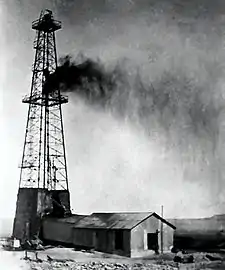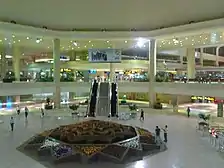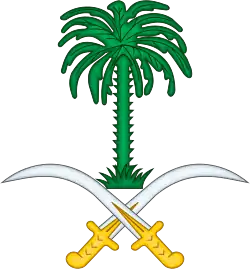Eastern Province, Saudi Arabia
The Eastern Province (Arabic: المنطقة الشرقية al-Mintaqah ash-Sharqīyah), also known as the Eastern Region, and officially the Emirate of the Eastern Province,[1] is the easternmost of the 13 provinces of Saudi Arabia. It is the largest province by area and the third most populous after the Riyadh Province and the Makkah Province. In 2017, the population was 4,900,325.[2] Of these, 3,140,362 were Saudi citizens and 1,759,963 were foreign nationals[3] The province accounts for 15.05% of the entire population of Saudi Arabia[2] and is named for its geographical location relative to the rest of the kingdom.
Eastern Province
المنطقة الشرقية | |
|---|---|
| al-Mintaqah ash-Sharqiyyah | |
 | |
| Country | |
| Capital | Dammam |
| Governorates | |
| Government | |
| • Governor | Prince Saud bin Nayef |
| • Deputy Governor | Prince Ahmed bin Fahd |
| Area | |
| • Total | 672,522 km2 (259,662 sq mi) |
| Area rank | 1 |
| Population (2017) | |
| • Total | 4,900,325 |
| • Rank | 3 |
| • Density | 7.3/km2 (19/sq mi) |
| Time zone | UTC+3 (Arabian Standard Time) |
| Area code(s) | 013 |
| ISO 3166 code | SA-04 |
More than a third of the population is concentrated in the Dammam metropolitan area. With an estimated population of 1.25 million as of 2019,[4] Dammam, the capital of the province, is the sixth most populous city in the kingdom. The incumbent governor of the province is Prince Saud bin Nayef Al Saud. Other populous cities in the province include Hofuf, Mubarraz, Hafr al-Batin, Jubail and Khobar.[5] The region is extremely popular among tourists for its beaches on the Persian Gulf and proximity to the other countries of the eastern Arab world, such as the United Arab Emirates, Qatar and Bahrain, with the latter being linked to the province via the 25 km (15 mi) long King Fahd Causeway. The region also shares a border with Oman. The province is bordered to the west, from north to south, by the provinces of the Northern Borders, Ha'il, Qassim, Riyadh and Najran.
The Eastern Province encompasses the entire east coast of Saudi Arabia and acts as a major platform for most of the kingdom's oil production and exports. Oil was first found in the country in the Eastern Province, at the Prosperity Well site (formerly known as Dammam No.7). The Ghawar oil field, located in the Ahsa Governorate, measuring 8400 sq.km. (3240 sq.mi.) is the largest oil field in the world,[6] and accounts for roughly a third of the kingdom's oil production. The Safaniya oil field, located off the coast of the province, is the largest offshore oil field in the world. The Jubail Industrial City, part of the city of Jubail, the fifth most populous in the province, is the largest industrial city in the world.[7]
The area was largely uninhabited until the Iron Age, when a few people migrated over from the Achaemenid and Macedonian empires. For most of the early medieval period, the region was under Persian and Sasanian rule until the advent of Islam under Muhammad, and subsequently, the Islamic empires during the Islamic Golden Age. After a brief period of British rule during the early modern period, the Unification of Saudi Arabia led to the consolidation of the region into the Kingdom of Hejaz and Nejd, which in 1932, was united into the modern Kingdom of Saudi Arabia.
Geography

Approximately two-thirds of the province is desert, comprising, from south to north, the Rub' al Khali, Dahna and Nafud deserts, with the Rub' al-Khali alone making up more than half of the area of the province. Areas such as Hafr al-Batin and the Ahsa Oasis have become important sites for desert farming due to the advancements made during the Green Revolution in farming and irrigation techniques.
The entire eastern coast of the kingdom lies in the Eastern Province. The region borders, from north to south, the countries of Iraq, Kuwait, Bahrain, Qatar, United Arab Emirates and Oman.
History

The northern part of the Eastern Province was first inhabited by the Lakhmids around 300 AD, with the coastal regions claimed by the Sasanians but governed by the Lakhmids. Much of the Eastern Province was under Sasanian rule at the time of Muhammad. The entire Arabian Peninsula fell into Muslim hands during the Rashidun Caliphate and the Muslim conquest of Persia, after Muhammad's death.[8] The region stayed stable during the first three Islamic caliphates.

During the Abbasid Caliphate, the region was taken over by the Qarmatians, a Shi'ite group of the Isma'ili branch, around 899 AD. The Qarmatians attacked Makkah and Madinah and held the Black Stone to ransom in Ahsa in 920 AD. The region was ruled by the Qaramatians until 976 AD, when after losing to the Abbasids, they were reduced to the status of a local power. After Bahrain and Qatif seceded from Qarmatian rule around 1058 AD, they retreated to the Ahsa Oasis, to which Abdullah bin Ali Al Uyuni laid siege and invaded in 1076 AD, ending the rule of Qarmatians in Ahsa and founding the Uyunid Emirate.[8]
Not much is known of the Uyunids, except that they were the descendants of the Banu Abdul Qays tribe. They were involved in several internal disputes, causing the emirate to become unstable and eventually leading to the rise of the Bedouin Usfurids. The Usfurids saw a short period of stability. After overthrowing their former allies, the Uyunids, they had an uneasy relationship with the Persian rulers of Hormuz, who took control of the former Uyunid cities of Qatif and Bahrain around 1320 AD. This eventually led to the fall of the Usfurids. The region was mostly overlooked until the 1500s, when the Jabrids took over around 1507 AD, but they too fell due to internal conflicts in or around the 1540s.[8]
In 1551 AD, the Ottomans invaded the region during their first war with the Safavids, and kept it under their control until 1671.[8] After several years of unrest between the Ottomans, Saudis and Rashidis, the Emirate of Nejd and Hasa, also known as the Third Saudi State, under Ibn Saud, took the entire Arabian Peninsula from Ottoman and Rashidi control. Most of the Eastern Province came under the Hasa region, and as such, the emirate has been under Saudi control since 1902. In 1923, the Dawasir of Bahrain moved into the area which is now Khobar, and later spread into Dammam, and they are credited with the foundation of the two cities.
Demographics
| Population pyramid 2016 | ||||
| % | Males | Age | Females | % |
| n/d | 85+ | n/d | ||
| 0.17 | 80–84 | 0.19 | ||
| 0.2 | 75–79 | 0.21 | ||
| 0.33 | 70–74 | 0.28 | ||
| 0.48 | 65–69 | 0.46 | ||
| 1.18 | 60–64 | 0.67 | ||
| 2.18 | 55–59 | 1.05 | ||
| 3.36 | 50–54 | 1.50 | ||
| 4.88 | 45–49 | 2.20 | ||
| 6.60 | 40–44 | 3.11 | ||
| 7.76 | 35–39 | 3.78 | ||
| 6.58 | 30–34 | 4.07 | ||
| 5.80 | 25–29 | 4.43 | ||
| 4.45 | 20–24 | 3.63 | ||
| 3.41 | 15–19 | 3.02 | ||
| 3.82 | 10–14 | 3.41 | ||
| 4.53 | 5–9 | 4.03 | ||
| 4.23 | 0–4 | 3.98 | ||
Population
According to the Population Characteristics Surveys conducted by the General Authority for Statistics, the Eastern Province had a population of 4,900,325 as of December 2017,[2] of which 3,140,362 were Saudis and 1,759,963 were foreign nationals. The Eastern Province is the third most populous province in Saudi Arabia, after Makkah and Riyadh. With an estimated population of 1,225,000 as of 2019,[4] Dammam is the most populous city in the province and the sixth most populous city in the country. The governorate with the largest population is the Ahsa Governorate. It is also the largest governorate in terms of land area. The province had the lowest dependency ratio in the kingdom at around 36%, as of 2016.[9] The sex ratio for Saudis was 109 males per 100 females and 150 males per 100 females for non-Saudis, yielding a common sex ratio of 151 males per 100 females.[9] 1% of children in the province were orphans.[9]
Religion
Censuses in Saudi Arabia do not collect or report data regarding religion. Sunni Islam of the Hanbali school of Islamic jurisprudence is the predominant religion overall in the country, with smaller numbers of Hanafis, Shafi‘is and Malikis. Shia Muslims form a majority in some parts of the Eastern Province, particularly in Qatif.[10] An extremely small number of Hindus, Christians and other religious groups does exist, most of whom are expatriates from India and the Philippines. They live in highly localized communities spread over the region, mostly in the Triplet Cities of Dammam, Khobar and Dhahran.
Languages
The official language of Saudi Arabia is Arabic. The three main regional dialects spoken by Saudis are Hejazi Arabic,[11] Najdi Arabic,[12] and Gulf Arabic.[13] Approximately 2 million people speak Gulf Arabic, a dialect spoken exclusively in the Eastern Province.[14] The remaining Arabic speakers in the province speak one of the other two dialects, more commonly the Najdi dialect.[14][15] Saudi Sign Language is the principal language of the deaf community. The large expatriate communities also speak their own languages, the most numerous of which are some of the Indian languages, Filipino/Tagalog, Bengali and Urdu.[16][17]
Education
From 1,264,687 male residents who were above the age of 10, 88.78%, representing 1,122,738 persons had some form of formal education, while 141,949 were illiterate.[9] As for females, from the 1,161,677 residents above the age of 10, 80.77% or 938,233 persons were formally educated, while 223,444 were illiterate.[9]
Housing
44.42% of residential units in the Eastern Province are apartments and 96.29% of residential units are made of concrete.[9] Homelessness was not reported.[9]
Health
3.51% of the province's Saudi residents, who were above the age of 15, reported some form of disability in 2016, with visual impairment being the most common form of disability and 42,052 persons suffering from some form of visual impairment.[9] 58,000 persons reported severe or extreme disability.[9] 285,754 Saudi residents above the age of 15 reported that they were currently smoking, with 254,233 reporting daily smoking and 31,521 reporting intermittent smoking.
Governors
| Names | Position held | Appointed by |
|---|---|---|
| Abdullah bin Jalawi | 1912-35 | Abdul Rahman bin Faisal Al Saud |
| Saud bin Abdullah bin Jalawi | 1935-67 | King Abdulaziz Al Saud |
| Abdulmuhsin bin Abdullah Al Jalawi | 1967-85 | King Faisal Al Saud |
| Muhammad bin Fahd | 1985-2013 | King Fahd Al Saud |
| Saud bin Nayef | 2013-present | King Abdullah Al Saud |
Economy

The economy of the Kingdom of Saudi Arabia is largely dependent on oil. As such, the Eastern Province, being the province with most of Saudi Arabia's oil reserves enjoys a high economic position. Saudi Aramco, the state-owned oil company of Saudi Arabia and an organization of major significance in the petroleum industry, is based in Dhahran in Greater Dammam. It became the fifth company in the world to reach a market capitalization of $1 trillion ($1,000,000,000,000) on December 11, 2019. After going public the same day in what is considered the largest public offering ever as of December 2019, the next day, on December 12, 2019, the company reached a market cap of $2 trillion, becoming the first and only company in the world to break the record.[18]

The kingdom's main oil and gas fields are located in the Eastern Province with sites such as the Ghawar Field, the largest onshore oil field in the world and the Safaniya oil field, the largest offshore oil field in the world. Petroleum is refined in various refineries spread across the kingdom and shipped to dozens of countries from port cities such as Ra's Tanura. The East–West pipeline enables efficient transport of oil from the eastern oil fields and refineries to the western refineries and ports, such as Rabigh and Jeddah.
Saudi Arabia's largest agricultural product, dates, also forms a large part of the province's economy. Every year thousands of tonnes of dates are harvested from the date palms in the giant oasis of Ahsa to be sold in and around the kingdom.
Transportation

Dammam's King Fahd International Airport, operating since October 1999,[19] the largest airport in the world in terms of land area, serves as the primary hub for the entirety of the Eastern Province.[19] Located 30 km northwest of the city, the airport is well connected by air to 43 destinations in the Middle East, Asia, and Europe, provided by 37 airlines. Other airports in the province include Ahsa International Airport and Qaisumah-Hafr Al Batin Airport. Saudi Aramco has a separate terminal at the King Fahd International Airport for their employees and aircraft with scheduled flights to Shaybah, Yanbu, Jeddah and other sites where the company is active.
Built in the 1940s, the King Abdulaziz Sea Port, located on the coast of the Persian Gulf, is the second largest and second busiest port in Saudi Arabia, after the Jeddah Islamic Port in Jeddah. It is also the largest port in the Persian Gulf. The port is equipped with 9 ports with 214 platforms.[20] The port receives more than 15,000 ships carrying more than 13 million containers or 532 million tons of cargo annually.[20]
Highway 95 (Route 5M) connects Khafji on the Kuwaiti border in the north to the Ramlah border station on the Omani border in the south via Jubail, Ra's Tanura, the Dammam metropolitan area, the Salwa border station on the Qatari border and the Batha' border station with the United Arab Emirates. Highway 40 (Route 80M) connects Bahrain and Dammam via the 25 km (15 mi) King Fahd Causeway over the Persian Gulf and onward to Jeddah on the Red Sea via Riyadh, Ta'if and Makkah. Highways 605, 610, 613, 614, 615, 617 and 619, known locally by other popular names, connect the Greater Dammam area to Ra's Tanura, Jubail, the King Fahd International Airport, Abqaiq and Hofuf.

Intercity bus services are operated in the province by the Saudi Arabian Public Transport Company (SAPTCO).[21] Umrah and Hajj shuttle services are also provided to residents of the kingdom by private contractors. Shuttle services also connect the Dammam metropolitan area to the Bahrain International Airport, northeast of Manama in Bahrain.
The Saudi Arabian railways are managed by two separate organizations, the Saudi Railways Organization and Saudi Railway Company. The lines in the Eastern Province, two lines, one passenger, which runs from Dammam to Riyadh via Abqaiq an Hofuf, and the other freight, which runs directly from Dammam to Riyadh, are managed by the Saudi Railways Organization (SRO).[22]
A plan to build a metro in Dammam was also in the works, but its current status is unknown.[23]
Administrative divisions
The Eastern Province is one of the 13 provinces of Saudi Arabia[24] (Arabic: مناطق إدارية; manatiq idāriyya, sing. منطقة إدارية; mintaqah idariyya). The region is further subdivided into 11 governorates (Arabic: محافظات; muhafazat, sing. محافظة; muhafazah). The governorates are further subdivided into sub-governorates (Arabic: مراكز; marakiz, sing. مركز; markaz).
The Eastern Province's capital city of Dammam has special status. Like the other 12 regional capitals, Dammam is not included within any governorate but is instead simply known as the City of Dammam, in Arabic, the word أمانة (amanah) is used and the city is headed by a mayor (Arabic: أمين; amin). The Ahsa Governorate, which includes the traditional oasis of Ahsa and the Rub' al Khali desert, which comprises more than half of the governorate itself, is the largest governorate in Saudi Arabia in terms of area.
List of governorates
| Name | Arabic Name | Population (2010) |
|---|---|---|
| Ahsa Governorate | محافظة الأحساء | 1,063,112 |
| City of Dammam | أمانة الدمام | 903,597 |
| Khobar Governorate | محافظة الخبر | 578,500 |
| Qatif Governorate | محافظة القطيف | 524,182 |
| Hafr Al Batin Governorate | محافظة حفر الباطن | 389,993 |
| Jubail Governorate | محافظة الجبيل | 378,949 |
| Dhahran Governorate | محافظة الظهران | 120,521 |
| Khafji Governorate | محافظة الخفجي | 76,279 |
| Ra's Tanura Governorate | محافظة رأس تنورة | 60,750 |
| Abqaiq Governorate | محافظة بقيق | 53,444 |
| Na'iriyah Governorate | محافظة النعيرية | 52,340 |
| Qaryat Al Ulya Governorate | محافظة قرية العليا | 24,634 |
See also
References
- "Emirate of Eastern Province". Ministry of Interior.
- "Population Characteristics surveys" (PDF). General Authority for Statistics. 2017.
- "Riyadh most populous Saudi city, Makkah most populous province". Arab News. 2012-02-25. Retrieved 2020-04-02.
- "Ad-Dammam, Saudi Arabia Population 1950-2020". www.macrotrends.net. Retrieved 2020-04-02.
- worldpopulationreview.com https://worldpopulationreview.com/countries/saudi-arabia-population/cities/. Retrieved 2020-04-02. Missing or empty
|title=(help) - "Ghawar Oil Field". Hydrocarbons Technology. Retrieved 2020-04-04.
- "The World's Largest Industrial Areas". WorldAtlas. Retrieved 2020-04-02.
- Atlas of world history, Black, Jeremy, 1955-, DK Publishing, Inc., DK Pub, 2000, ISBN 0-7894-4609-X, OCLC 42953915CS1 maint: others (link)
- "Demographic Survey 2016" (PDF). General Authority for Statistics.
- "الشيعة في السعودية: من التهميش إلى الاحتواء".
- Arabic, Hijazi Spoken. Ethnologue
- Arabic, Najdi Spoken. Ethnologue
- Arabic, Gulf Spoken. Ethnologue
- Frawley, William (2003). International Encyclopedia of Linguistics, Volume 1. William Frawley. p. 38. ISBN 9780195139778.
- Languages of Saudi Arabia Ethnologue
- "Migrant Communities in Saudi Arabia", Bad Dreams: Exploitation and Abuse of Migrant Workers in Saudi Arabia, Human Rights Watch, 2004
- Saudi Arabia. Ethnologue
- Business, Charles Riley, CNN. "The world has its first $2 trillion company. But for how long?". CNN. Retrieved 2020-04-03.
- "About King Fahd International Airport | King Fahd International Airport". kfia.gov.sa. Retrieved 2020-04-04.
- Mawani. "King Abdulaziz Port Dammam King Abdulaziz Port Dammam". mawani.gov.sa. Retrieved 2020-04-04.
- "SAPTCO - InterCity Transport". SAPTCO - InterCity Transport. 1 April 2020. Retrieved 1 April 2020.
- "SRO". www.saudirailways.org. Retrieved 2020-04-04.
- 2014-05-23T11:26:00+01:00. "Dammam metro plans announced". Railway Gazette International. Retrieved 2020-04-04.
- "Saudi Arabia: Administrative divisions". arab.net.

